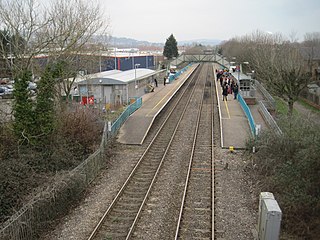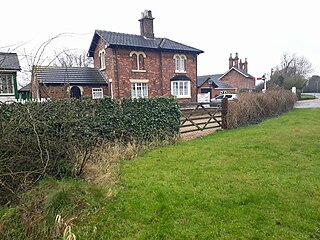
Cwmbran railway station is in the northeast of Cwmbran town centre, within five minutes' walking distance. It is part of the British railway system owned by Network Rail and is managed by Transport for Wales, who operate all trains serving it. It lies on the Welsh Marches Line from Newport to Hereford. The station was opened at this site in 1986 to serve the commuter route to Newport and Cardiff, and shoppers to the town centre.

Aberbeeg railway station served the village of Aberbeeg in Monmouthshire, Wales. It was the junction where the Monmouthshire Railway and Canal Company's lines from Newport to Brynmawr and Ebbw Vale diverged.

Cwm railway station served the village of Cwm in Monmouthshire, Wales.

Sandy railway station serves the town of Sandy in Bedfordshire, England. It is on the East Coast Main Line, about 44 miles (71 km) from London King's Cross. Sandy is managed and served by Great Northern.

Saxby railway station was a station serving the villages of Saxby and Freeby, Leicestershire. It was located between the two villages.

Nassington railway station is a former railway station in Nassington, Northamptonshire. It was owned by the London and North Western Railway but from 1883 to 1916 was also served by trains of the Great Northern Railway. It opened for passengers along with Wakerley and Barrowden railway station and King's Cliffe railway station on 1 November 1879, on a new section of line constructed from Wansford Line Junction at Seaton to Yarwell Junction at Wansford.

Sibsey was a railway station on the East Lincolnshire Railway which served the village of Sibsey in Lincolnshire between 1848 and 1964. Withdrawal of passenger services took place in 1961, followed by goods facilities in 1964. The line through the station remains in use as part of the Poacher Line between Boston and Skegness.

Little Steeping was a railway station on the East Lincolnshire Railway which served the hamlet of Little Steeping in Lincolnshire between 1848 and 1964. It became a junction station in June 1913 when the Kirkstead and Little Steeping Railway was opened to provide a more direct route to Skegness for East Midlands holidaymakers. Withdrawal of passenger services took place in 1961, followed by goods facilities in 1964. The line through the station remains in use as the Poacher Line, although the Kirkstead and Little Steeping Railway closed throughout on 5 October 1970.

Willoughby was a railway station on the East Lincolnshire Railway which served the village of Willoughby in Lincolnshire between 1848 and 1970. In 1886, a second larger station replaced the first following the opening of a junction with the Sutton and Willoughby Railway to Sutton-on-Sea and later Mablethorpe. The withdrawal of goods facilities at Willoughby took place in 1966, followed by passenger services in 1970. All lines through the station are now closed.

Legbourne Road was a railway station on the East Lincolnshire Railway which served the village of Legbourne in Lincolnshire between 1848 and 1964. The station was closed to passengers in 1953, and withdrawal of goods facilities took place in 1964. The line through the station closed in 1970. The station once housed a museum containing railway memorabilia; this closed in 1998 and the building is once again a private residence.
Waltham was a railway station on the East Lincolnshire Railway which served the villages of New Waltham and Humberston in Lincolnshire between 1848 and 1964. It was originally named Waltham and Humberstone, but Humberstone was dropped soon after opening. The line through Waltham remained open for freight until December 1980.

Holton Village Halt was a railway halt on the East Lincolnshire Railway which served the village of Holton-le-Clay in Lincolnshire between 1905 and 1961. The station, which opened as part of a new motor train service between Grimsby and Louth, was the second station to serve the village after Holton-le-Clay and Tetney situated further to the south. The line through Holton-le-Clay remained open for freight until December 1980.

Fotherby Halt was a railway halt on the East Lincolnshire Railway which served the village of Fotherby in Lincolnshire between 1905 and 1961. The station was opened on the site of a previous station named Fotherby Gate House which had closed in 1872. The second station closed in 1961, but the line through it remained open for freight until December 1980. The line through the station could be reopened by the Lincolnshire Wolds Railway as part of its extension south from Ludborough to Louth.

Alvescot railway station was a railway station between the Oxfordshire villages of Alvescot and Black Bourton, in England. It was Oxford, Witney and Fairford Railway between Oxford and Fairford.

Witney railway station served the Oxfordshire town of Witney on the Oxford, Witney and Fairford Railway line. It consisted of two stone-built platforms, a station building, a signal box, and a shed in the form of a pagoda.

Kelmscott and Langford railway station was a railway station south of the village of Langford on the Oxford, Witney and Fairford Railway, between Oxford and Fairford.

Lechlade railway station served the small town of Lechlade in Gloucestershire, England. The station was on the Oxford, Witney and Fairford Railway, between Oxford and Fairford, it was built where the line crossed the road to Burford, 0.5 miles (0.80 km) north of Lechlade.
Tempsford railway station was a railway station built by the Great Northern Railway to serve the village of Tempsford in Bedfordshire, England.

Grainsby Halt was a railway halt on the East Lincolnshire Railway which served the hamlet of Grainsby in Lincolnshire between 1905 and 1952. The station, which opened as part of a new motor train service between Grimsby and Louth, was opened to serve a Victorian hall situated 2 miles (3.2 km) to the west. The station, one of the smallest to be taken over by British Railways on nationalisation in 1947, never really justified its existence and closed in 1952 following a period of temporary closure during the Second World War. The line through Grainsby remained open for freight until December 1980.
Hainton Street Halt was a railway halt on the East Lincolnshire Railway which served the Welholme Road area of Grimsby in Lincolnshire between 1905 and 1961. The station was opened as part of a new motor train service between Grimsby and Louth. The station briefly closed in 1939 as a Second World War economy measure, but reopened in 1940. The line through Hainton Street remained open for freight until December 1980. The trackbed was later reused by Humberside County Council to construct the A16 Peaks Parkway which now runs through the site. Building of the road put an end to the aspirations of the Great Northern and East Lincolnshire Railway plc to reopen the line as a heritage railway.

















